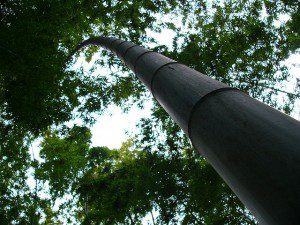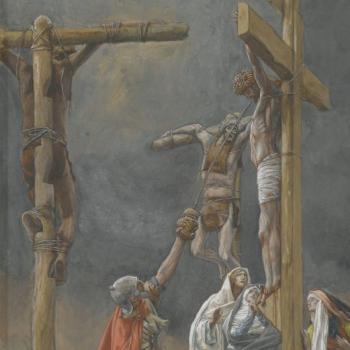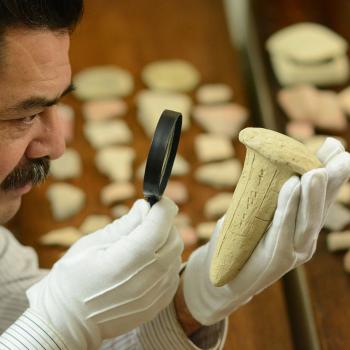One of the most moving depictions I have come across in literature is John Steinbeck’s closing in Grapes of Wrath.[1] There one of the Oklahoman migrants to California during the Great Depression has just given birth to a stillborn baby. Yet she (Rose of Sharon) takes it upon herself to breastfeed a starving man who had sought shelter with her family in a barn. Here is Steinbeck:
For a minute Rose of Sharon sat still in the whispering barn. Then she hoisted her tired body up and drew the comfort about her. She moved slowly to the corner and stood looking down at the wasted face, into the wide, frightened eyes. Then slowly she lay down beside him. He shook his head slowly from side to side. Rose of Sharon loosened one side of the blanket and bared her breast. “You got to,” she said. She squirmed closer and pulled his head close. “There!” she said. “There.” Her hand moved behind his head and supported it. Her fingers moved gently in his hair. She looked up and across the barn, and her lips came together and smiled mysteriously.
Steinbeck was a devout humanist who admired human decency and the resilience of the human spirit. His admiration of their resilience is on display in this account of Oklahomans who had migrated to California in the 1930s during the Great Depression as a result of the Dust Bowl disaster to find stable work. They experienced incredible suffering in California due to horrible circumstances, including oppressive working conditions. Steinbeck’s novel served to draw national attention to their plight.[2]
In addition to the migrants in California, the Great Depression and the ensuing Second World War formed a resilient generation in America sometimes referred to as “The Greatest Generation.”[3] The same could be said of the Japanese people who emerged from the extreme aftermath of World War II. A recent trip to Japan, including Nagasaki, reminded me once again of how much adversity the Japanese overcame to rebuild their society. Across the globe we find people who are resilient—like bamboo in a typhoon.
Resilience is a rare art form, which like the artist who crafts the art, is likely the combination of nature (i.e., inherent ability or skill) and nurture (i.e., dedication to the trade/art). Like a thoughtful art critic, science has weighed in on what makes people resilient. There are many factors that help shape resilient people who do not allow victimizing circumstances to define them. Rather, they rise above the ash-heap.[4] While resilience is an art form, it is not magic which makes it possible for people to escape unharmed from adversity, a point made by Hara Estroff Marano in “The Art of Resilience” in Psychology Today.[5] One does not wave a magic wand and people become resilient. While people’s genetic wiring varies in how different individuals handle stress, humans can cultivate resilience. Attitudinal and social dynamics that are cultivated over time play important roles in cultivating resilience.[6] Such dynamics include beliefs: “At the heart of resilience is a belief in oneself—yet also a belief in something larger than oneself.”[7]
Speaking of beliefs and dynamics involving beliefs, how might religious traditions play a role in fostering or cultivating resilience? Many religions provide a sense of individual and corporate worth and offer humanity a place in a seemingly indifferent cosmos so that we can find our bearings and rise above the fray. In addition, religions often play a key role in fostering group identity. If resilience is aided by group identity, and if groups are cultivated in part by religious cohesion, then religion often helps with resilience. But religion can also challenge group identity through that same above-mentioned affirmation of the individual’s worth as well as through what I will call religion’s prophetic dimension of voicing the moral conscience and calling for civil disobedience. The celebration of the individual and the prophetic can prove helpful at times to the group in helping it to proceed toward more wholesome social cohesion (as discussed in a prior essay in this section of the volume). The transcendent grants stability as well as goads us, destabilizing us for constructive change.
Social psychologist Jonathan Haidt seeks to get at this dual dynamic involving the preserving and destabilizing dimensions in society in terms of what he takes to be a greater wonder than the formation of the Grand Canyon: the biological and cultural evolution of cohesive groups and societies, where religion plays a solidifying role, yet while including the prophetic or non-conserving dimension, too.[8] God can work through secondary causation, including the formation of religions in part through natural means. If there is a Creator, and/or religion is a result (at least in part) of biological and cultural forces that help individuals and communities come together to survive and thrive in the midst of adversity, it would make sense that we account for religious treatments in caring for people dealing with trauma and tragedy, including end-of-life care.[9] It is encouraging to see that science is becoming more holistic and moving beyond Freudian and Skinnerian-like reductionistic accounts of treating people experiencing trauma and tragedy and in fostering mental health. Perhaps it is those who reject religious and spiritual dimensions entirely who are delusional.[10]
Not only should science account for “supernatural” elements in helping to foster mental, social and physical health, but also religion should account for “natural” elements, too. Jesus made great use of the natural world—like grape vines and grapes, the mustard seed, sheep and birds and sand and rocks—in his teachings about God’s kingdom. I doubt Jesus had recourse to bamboo in the Middle East from which to explain spiritual truths to people in his day, but many people across the globe are at least somewhat familiar with it today. Bamboo can speak to spirituality and make points that resonate with spiritual truths. Like bamboo, we must grow to be the kind of people who bend but do not break during the storms of life.[11]
We must not allow the victimizing circumstances of life to keep us down. We can draw from classics pieces of literature like Grapes of Wrath, or from religion, science and bamboo to help us craft our lives to be rare art forms.
_________________________
[1]John Steinbeck, Grapes of Wrath, Steinbeck Centennial Edition (New York: Penguin Books, 1939, 1967), page 455.
[2]http://www.steinbeck.org/pages/the-grapes-of-wrath-book-synopsis.
[3]https://www.nytimes.com/books/first/b/brokaw-generation.html.
[4]For articles on resilience, see the following: Hara Estroff Marano, “The Art of Resilience: Research on resilience breaks down the myth that a troubled childhood leaves us emotionally crippled as an adult,” in Psychology Today, May 1, 2003; Brad Waters, “10 Traits of Emotionally Resilient People: Part 1 of 2 in this blog series, ‘Cultivating Resilience for Total Well-Being,’” in Psychology Today, May 21, 2013; Denise Cummins, “Why Some People Are More Resilient Than Others: A recent study discovered two factors that characterize resilient people,” in Psychology Today, March 11, 2015.
[5]See also http://www.theatlantic.com/health/archive/2013/03/the-benefits-of-optimism-are-real/273306/.
[6]Think here of the Japanese people recovering from the atomic bombing of Nagasaki or the Fukushima disaster involving the earthquake, typhoon, and nuclear power plant meltdown tragedy. Consider the following on Japan’s response to various disasters: http://usatoday30.usatoday.com/news/world/2011-03-14-quakepsyche14_ST_N.htm. While Japan may have operated unwisely prior to, and initially in response to, the nuclear power plant tragedy, its “National Resilience” program is viewed by some as state of the art. For a discussion of its “National Resilience program (kokudo kyoujinka), see http://www.globalresearch.ca/fukushima-japans-national-resilience-and-the-legacy-of-3-11/5514830.
[7]See: https://www.psychologytoday.com/articles/200305/the-art-resilience. Whether or not belief in oneself played a role in the cultivation of Japanese resilience historically, a reason offered for Japan’s resurgence in the form of economic vitality following World War II was the “Social mobilization of the Japanese: sacrifice for the nation’s place in international economy.” This is a form of what Marano (above) refers to as “a belief in something larger than oneself.” It is claimed that “Ultimately it was the Japanese consumers who bore the brunt of shouldering the cost of Japanese companies’ competition abroad, in the form of high cost of consumer goods. After the war, they were taught to redirect their devotion to the nation from its military expansion to economic expansion. They were constantly exhorted that they were a homogeneous people and superior to all other Asians, and superior even to the whites. To establish their national position in the postwar world, they should not be very concerned about individual well being, thus should not mind the high cost they have to pay for consumer goods that cost less abroad. It is the same kind of mentality that prevented the Japanese from talking about their worries and pressure and ethnic/religious differences that Norma Field discusses in her In the Realm of A Dying Emperor, while worries, anger, and frustration still pop up unexpectedly, often from the periphery instead of mainstream Japanese society” (http://www.iun.edu/~hisdcl/h207_2002/jecontakeoff.htm). Note as well the reasons offered for Japan’s phenomenal resurgence following the aftermath of WWII at this site: https://www.quora.com/How-did-Japan-rebuild-itself-and-become-an-advanced-nation-and-a-major-economic-power-in-the-aftermath-of-the-World-War-II.
[8]Jonathan Haidt, “The Moral Roots of Liberals and Conservatives,” TED, September 2008. Haidt makes special mention of Eastern religions, which he takes to signify the movement beyond polarities like good and evil. As in these Eastern traditions, he calls for the left and right to work together—like yin (dark) and yang (bright), or like Vishnu the preserving deity and Shiva the destroying deity. In each case, for all their seeming opposition, they are interconnected and require one another. While I appreciate Haidt’s important attempts to account for the import of religion, including Eastern religions, it is worth noting that Joshua Greene believes Haidt does not safeguard sufficiently against the charge of moral relativism. See for example Greene’s work, Moral Tribes: Emotion, Reason, and the Gap Between Us and Them (New York: Penguin Press, 2013). Indeed, while Eastern religious traditions may have much to offer in terms of their emphasis on harmony, their monistic orientation does not safeguard sufficiently against the ultimate eradication of the distinction between good and evil; if the ultimate—God, the One—is beyond good and evil, how do we distinguish between them, and fight against evil in service to the good? Is not everything morally relative?
[9]Regarding a more constructive engagement of spirituality and its incorporation into end-of-life care, see Christina M. Puchalski, M.D. and Betty Ferrell, R.N., Ph.D., with a foreword by Rachel Namoi Remen, M.D., Making Health Care Whole: Integrating Spirituality into Patient Care (West Conshohocken, PA: Templeton Press, 2010).
[10]On religion’s role in fostering mental health, see: http://www.apa.org/news/press/releases/2013/03/religion-spirituality.aspx; http://www.health.harvard.edu/mind-and-mood/easing-grief-through-religion-and-spirituality; and http://greatergood.berkeley.edu/article/research_digest/religion_and_resilience (mention is made in at least one of these article that while religion often helps in fostering mental health, there are also religious accounts that can prove detrimental to our health).
[11]See: https://www.psychologytoday.com/blog/design-your-path/201305/10-traits-emotionally-resilient-people. With this point on the metaphorical importance of bamboo in mind, I was especially struck by the use of bamboo presented at the website for “The Resilience Programme,” which is dedicated to fostering resilience among individual employees and businesses in the workplace: “be flexible yet firmly rooted”; “commit to continuous growth”; “what looks weak is strong”; “be ever ready”; “find wisdom in emptiness”; and “express usefulness through simplicity”. I encourage readers to reflect upon these headings at The Resilience Programme’s site: http://www.theresilienceprogramme.co.uk/resilience-programme/bamboo.














